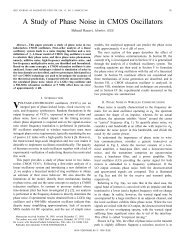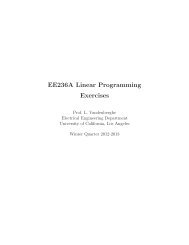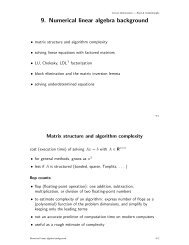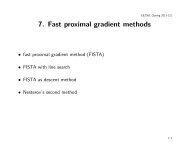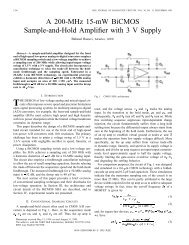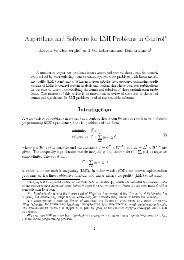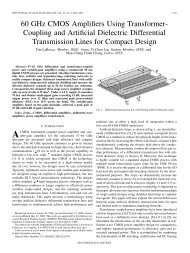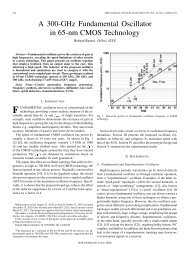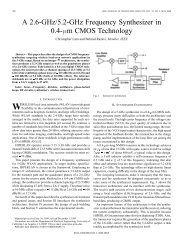Power Analysis for High-Speed I/O Transmitters
Power Analysis for High-Speed I/O Transmitters
Power Analysis for High-Speed I/O Transmitters
You also want an ePaper? Increase the reach of your titles
YUMPU automatically turns print PDFs into web optimized ePapers that Google loves.
<strong>Power</strong> <strong>Analysis</strong> <strong>for</strong> <strong>High</strong>-<strong>Speed</strong> I/O <strong>Transmitters</strong><br />
Hamid Hatamkhani, Chih-Kong Ken Yang<br />
University of Cali<strong>for</strong>nia, Los Angeles<br />
9 Marisol, Newport Coast, CA, 92657, USA<br />
Tel: 1-949-246-6129, E-mail: hhatam@icsl.ucla.edu<br />
Abstract<br />
This paper studies the design tradeoffs to minimize<br />
power dissipation of multi-Gbps parallel I/O transmitters. A<br />
macromodel of a transmitter that can be optimized <strong>for</strong> power<br />
is presented. Also discussed is a means to consider the impact<br />
of deterministic jitter due to on-chip buffering on power<br />
dissipation. The model allows analysis that considers varying<br />
design constraints, and circuit architectures. The optimization<br />
results provide some guidance on the choice of architecture,<br />
and data rate to achieve large aggregate I/O bandwidths.<br />
Introduction<br />
As the off-chip bandwidth of ICs is anticipated to<br />
exceed 1Tb/s within the next 5 years [7], power dissipation by<br />
the I/O is an increasing concern. In order to maintain<br />
reasonable power consumption, both the signaling and the<br />
transmitter architecture must be carefully considered and<br />
designed <strong>for</strong> low power.<br />
This paper considers the three sources of power<br />
consumption: the signaling power (power driven off-chip),<br />
driver and pre-driver power (the buffering required to drive<br />
the signal), and the signal-conditioning power (the power<br />
required to maintain good signal integrity). By using a<br />
detailed circuit model that relates output data eye (transmitter<br />
per<strong>for</strong>mance) with transistor size, we can optimize the design<br />
<strong>for</strong> power given various link specifications such as data rates,<br />
signaling levels, signal integrity requirements, and process<br />
technology. This paper studies the trade-off between the link<br />
specifications and power dissipation <strong>for</strong> a multi-Gbps<br />
transmitter. The optimization would indicate desired data<br />
rates <strong>for</strong> optimal power dissipation, and the achievable<br />
minimum power dissipation <strong>for</strong> large aggregate bandwidth<br />
links.<br />
Transmitter Architecture<br />
The basic transmitter architecture in this study, as<br />
shown in Fig. 1, assumes several design conditions. The input<br />
data rate arrives at half the rate of the transmitted output. The<br />
capacitance driven by each input data bit is less than the<br />
equivalent capacitance of a gate width that is 8*Lmin (<strong>for</strong><br />
NMOS). The clock loading is also a gate width of 8*Lmin.<br />
Additional retiming latches and switches are used to precondition<br />
the data <strong>for</strong> pre-emphasis. A pre-driver and driver<br />
produce the output signal with the desired output swing,<br />
common-mode voltage and output impedance.<br />
X[<br />
n]<br />
Mux Buf<br />
PDrv Drv<br />
2x1<br />
Sw<br />
X[ n −1]<br />
Fig.1: Transmitter block diagram<br />
Two common signaling levels are investigated: low<br />
common-mode (LCM) and high common mode (HCM). With<br />
LCM, the output driver devices are in triode and provide<br />
impedance matching (Fig. 2c and Fig. 2d). With HCM, the<br />
output driver devices work in saturation and per<strong>for</strong>m current<br />
steering to the output. A 50 ohms resistor provides the<br />
impedance matching (Fig. 2a and Fig. 2b).<br />
The amount of swing at the output of the driver is<br />
determined either by the specification or by calculating the<br />
amount of attenuation of the channel and sensitivity of the<br />
receiver. In most of the paper, the nominal output swing is<br />
250mV. Other swings are investigated later in the paper.<br />
X<br />
50<br />
Vdd<br />
Out<br />
50<br />
Out<br />
X1<br />
VG<br />
Vdd Vdd<br />
50<br />
Out<br />
X1<br />
(a) (b) (c) (d)<br />
Fig.2: Output drivers: (a) single-ended HCM (b) differential HCM<br />
(c) single-ended LCM (d) differential LCM.<br />
The study not only considers the basic transmitters<br />
but also the impact of signal integrity. To reduce ISI, a firstorder<br />
(2-tap) pre-emphasis filter is used in the study.<br />
(1)<br />
Our analysis studies a digitally implemented pre-emphasis.<br />
Switches (4-bits) choose between X[n] or X[ n − 1]<br />
to program<br />
η. The output driver is split into binary-weighted branches<br />
similar to a current-mode (HCM) or resistive (LCM) D/A<br />
converter [1,2]. Additionally, to consider output-swing<br />
control (HCM), and output-impedance control (LCM), the<br />
pre-driver is also designed and properly sized to use a<br />
feedback control voltage.<br />
Transmitter Model<br />
The transmitter power optimization is constrained by<br />
the desired output data-eye opening. The output voltage swing<br />
and common-mode level determine the driver architecture and<br />
transistor sizing. The signal-integrity considerations<br />
(specifically, swing control, impedance control, and preemphasis)<br />
determine the pre-driver and switching design.<br />
The output timing margin defines maximum<br />
tolerable jitter, both deterministic jitter (DJ) and random jitter<br />
(RJ). Since RJ is due to the clock source (i.e. a PLL) and<br />
supply/substrate noise, it is not considered in the model<br />
currently. DJ at the transmitter output (be<strong>for</strong>e the filtering of<br />
the channel), is primarily due to on-chip ISI that results from<br />
on-chip low-pass filtering 1 . The filtering is due to transistor<br />
sizing and fan-out within the transmitter. So one of the key<br />
optimization included in this model is the efficient device<br />
sizing to minimize power while constraining DJ. The DJ<br />
model <strong>for</strong> a first order system is:<br />
Tbit<br />
/<br />
DJ ( / Tbit<br />
) ln( 1 e )<br />
τ −<br />
Y[n] = X[n] -ηX[N<br />
-1]<br />
= − τ −<br />
(2)<br />
where τ is time constant of the system.<br />
1 Some amount (commonly
For several stages of logic, we approximate<br />
deterministic jitter of a stage denoted by i, with the following<br />
model:<br />
−X<br />
−Y<br />
⎧DJi<br />
= DJi−1<br />
− ( Atdi<br />
ln( 1−<br />
e ) + Ct di−1<br />
ln( 1−<br />
e )) / Tbit<br />
⎪<br />
(3)<br />
⎨ C(<br />
1−<br />
DJi−1<br />
) Tbit<br />
D(<br />
1−<br />
DJi−1<br />
) Tbit<br />
⎪X<br />
=<br />
, Y =<br />
⎩ t di<br />
t di−1<br />
A, B, C and D can be approximated by mean-square<br />
estimation method fitted to simulated data from various logic<br />
blocks in the transmitter (i.e. inverter chain and transmission<br />
gates). The delays (tdi and tdi-1) are modeled to within 15%<br />
error using an α-power model and the Elmore delay <strong>for</strong>mula<br />
[3,4]. Fig. 3 reports DJ relative error which is normalized to<br />
the t FO4<br />
/ T <strong>for</strong> two inverter chain. Chain 1 is composed of<br />
b<br />
six inverters which are sized with constant fanout (FO-4) at<br />
3Gbps. Chain 2 is six inverters with variable fanout (4, 9/8, 3,<br />
1.5, 2 and 4) at 3.5Gbps. The simulated data is from a 0.18-<br />
µm technology. The variable fanout case clearly stresses our<br />
model resulting in error of 20%. However, such large<br />
variations in fanout is not expected so the 20% can be<br />
considered as an error bound.<br />
%(DJ normalize relative error)<br />
20<br />
15<br />
10<br />
5<br />
Chain1: constant FO<br />
Chain2: variable FO<br />
0<br />
1 2 3 4 5 6<br />
Inverter number in the chain<br />
Fig.3: DJ normalized relative error. Chain1: 6 inverters sized in FO4<br />
Chain2: 6 inverters with fanout of: 4, 9/8, 3, 1.5, 2, 4<br />
The DJ model is used in an optimization to find<br />
device sizes that satisfy final output eye constraints. After<br />
determining the optimal device sizes based on the voltage and<br />
timing constraints, the total power can be calculated as a sum<br />
of the dynamic (on-chip CV 2 f and crowbar) power, and the<br />
off-chip signaling power. Note that since active power is the<br />
dominant, we do not consider leakage.<br />
We compare the optimization results from our model<br />
with Spice simulations <strong>for</strong> the power dissipation of basic<br />
transmitters. Fig.4 shows a good agreement between the<br />
results from Spice and the model. In this figure, simulation<br />
reports smaller values <strong>for</strong> power than the model. This is due<br />
to the assumption of switching activity in the model, which is<br />
different than the one in the simulation. Figure 5 reports the<br />
% error when comparing our model with Spice as we increase<br />
the data rate. The bit-time of the plot is normalized<br />
to t FO4<br />
/ T . The error is less than b<br />
± 10%<br />
.<br />
Since the signaling power remains essentially<br />
constant when driving a constant load impedance, one of the<br />
primary tradeoff in power is on-chip through optimizing the<br />
sizing <strong>for</strong> a given DJ.<br />
<strong>Power</strong>(mW)<br />
12<br />
10<br />
8<br />
6<br />
4<br />
2<br />
HCM<br />
LCM<br />
Simulation<br />
Model<br />
0<br />
2 3 4 5 6<br />
(bit time)/(FO4 delay)<br />
Fig.4: <strong>Power</strong> values from the model and Spice simulation <strong>for</strong> singleended<br />
HCM and LCM architecture with pre-emphasis. DJ=11% of<br />
bit time<br />
%(DJ normalized relative error)<br />
15<br />
10<br />
5<br />
0<br />
−5<br />
HCM<br />
LCM<br />
−10<br />
2 3 4 5 6<br />
(bit time)/(FO4 delay)<br />
Fig.5: Normalized DJ relative error <strong>for</strong> single-ended HCM and LCM<br />
architecture with pre-emphasis. DJ=11% of bit time.<br />
Achieving smaller DJ necessitates using smaller<br />
fanouts in gate sizing which in turn leads to increase in<br />
capacitance and power dissipation. Figure 6 shows the power<br />
of a single-ended LCM transmitter with pre-emphasis <strong>for</strong><br />
varying DJ specifications. Note that reducing the DJ to less<br />
than 11% causes considerable increase in power.<br />
From our initial analysis, power can be optimized by<br />
maximizing the DJ within the desired constraint. Furthermore,<br />
setting a proper DJ constraint (to no less than 9%) can impact<br />
power significantly.<br />
<strong>Analysis</strong> Using the Optimization Model<br />
Our analytical model can provide further insight into<br />
the design tradeoffs. Already shown is the power penalty of<br />
HCM compared to LCM. The model can also be used to<br />
illustrate the impact of pre-emphasis. There is clearly a<br />
tradeoff between power consumption and data rate. For a<br />
given desired aggregate data rate, there is an optimal data rate<br />
per pin 2 .<br />
2 This is equivalent to energy-per-bit
<strong>Power</strong>(mW)<br />
4.5<br />
4<br />
3.5<br />
3<br />
2.5<br />
2<br />
8 10 12 14 16 18 20<br />
DJ(% of bit time)<br />
Fig.6: DJ vs. power <strong>for</strong> a single-ended LCM architecture with preemphasis<br />
at 4Gbps. Process is 0.18µ.<br />
The impact of varying the output signal swing or DJ<br />
constraints can also be studied. Furthermore, by adjusting the<br />
model fitting parameters <strong>for</strong> a different technology, we can<br />
compare the optimal data rate <strong>for</strong> different technologies.<br />
Fig.7 shows the results of the model <strong>for</strong> LCM and<br />
HCM architectures. Since current standards limit the DJ to be<br />
less than 13% of bit time [5,6], we use 11% of bit time <strong>for</strong> the<br />
maximum tolerable DJ from on-chip buffering. For the LCM<br />
architecture, applying pre-emphasis is more power hungry at<br />
higher data rates. This can be explained by the larger logicrelated<br />
capacitance, which makes dynamic power dominant.<br />
Differential signaling reduces Ldi/dt noise considerably at the<br />
expense of more dynamic power budget. However, notice that<br />
the penalty is not significant, especially in HCM architecture,<br />
where signaling power is dominant. From the figure it is<br />
evident that HCM is not an interesting choice <strong>for</strong> power<br />
reduction <strong>for</strong> data rates of less than 4.5Gbps (bit-time of<br />
222ps in 0.18-µm technology).<br />
<strong>Power</strong>(mW)<br />
12<br />
10<br />
8<br />
6<br />
4<br />
2<br />
HCM<br />
LCM<br />
Simple<br />
pre−emphasis<br />
Pre−emphasis,Differential<br />
0<br />
2 4 6 8 10<br />
(bit time)/(FO4 delay)<br />
Fig. 7: <strong>Power</strong> dissipation in 0.18µ CMOS process. DJ=11% of bit<br />
time<br />
We next use the model to analyze the impact of the<br />
position of the multiplexing in the transmitter architecture.<br />
The multiplexing function can be placed at various places<br />
along the transmitter architecture (i.e. buffering, pre-emphasis<br />
switches, pre-driver, and driver). Figure 9 shows 2 possible<br />
placements: within the buffering and at the output. The output<br />
multiplexing implementations <strong>for</strong> both HCM and LCM is<br />
shown in Fig. 8. X1 and X2 are the half-rate inputs driven to<br />
the output on appropriate level of clock signal. Multiplexing<br />
at the output achieves higher-speed operation by reducing the<br />
on-chip data rate. However, it is at the expense of more power<br />
consumption because of larger device sizes and clock power.<br />
Figure 9 illustrates the increase in power. The on-chip logic<br />
power essentially doubles, as shown in the LCM case.<br />
<strong>Power</strong>(mW)<br />
12<br />
10<br />
8<br />
6<br />
4<br />
2<br />
(a) (b)<br />
Fig8: Output multiplexing (a) HCM (b) LCM<br />
LCM<br />
HCM<br />
Mux(middle)<br />
Mux(output)<br />
0<br />
2 4 6 8 10<br />
(bit time)/(FO4 delay)<br />
Fig.9: Comparison of two different multiplexing in single-ended<br />
LCM and HCM architecture with pre-emphasis. DJ=11% of bit time<br />
To achieve a data channel of a given aggregate data<br />
rate, transceivers are parallelized in a wide bus. The optimum<br />
data rate depends on power budget and number of I/O pins.<br />
<strong>Power</strong>(W)<br />
1<br />
0.9<br />
0.8<br />
0.7<br />
0.6<br />
CK<br />
X1<br />
50<br />
Vdd<br />
CK<br />
X2<br />
Out<br />
3.6FO4<br />
3.3FO4<br />
0.5<br />
2.5FO4<br />
Simple<br />
0.4<br />
pre−emphasis<br />
Pre−emphasis,Differential<br />
0.3<br />
2 4 6 8 10<br />
(bit time)/(FO4 delay)<br />
Fig.10: <strong>Power</strong> dissipation <strong>for</strong> sending 1Tbps data in LCM<br />
architecture. DJ=11% of bit time. Process is 0.18µ<br />
If the number of pins is not constrained, using the<br />
model we can find the appropriate data rate per pin <strong>for</strong><br />
minimum power. In LCM architecture, signaling power is<br />
X1<br />
CK<br />
CK<br />
VG<br />
Vs<br />
X2<br />
CK<br />
CK<br />
X1 2 X<br />
Vs<br />
Out
dominant only at low data rates. With increasing the data<br />
rates, dynamic power is dominant. Fig.10 illustrates the<br />
tradeoff and shows that the optimum bit time <strong>for</strong> each I/O in<br />
order to transmit a constant aggregate data rate of 1Tbps is<br />
3.6 FO4 <strong>for</strong> a differential transmitter using pre-emphasis. In<br />
HCM architecture, since power consumption is mainly due to<br />
signaling, it is more desirable to increase data rate in order to<br />
reduce the number of signaling I/O outputs. The optimum bit<br />
time <strong>for</strong> each I/O in order to transmit a constant aggregate<br />
data rate of 1Tbps is 2.4FO4 <strong>for</strong> a single-ended HCM<br />
architecture with pre-emphasis. However it is 4.7 times more<br />
power hungry than single-ended LCM architecture with preemphasis.<br />
There<strong>for</strong>e LCM is more interesting <strong>for</strong> power<br />
reduction if the number of pins is not constrained. We will<br />
concentrate on this architecture <strong>for</strong> the remaining analyses.<br />
Raising the output swing increases signaling power<br />
dissipation. However, the larger swing also leads to bigger<br />
devices at the output driver. With both signaling and dynamic<br />
power increasing, the shift in the optimal bit-time is not<br />
immediately. Our optimization shows that the increase in<br />
dynamic power is less than the increase in signaling power<br />
and there<strong>for</strong>e the optimum data rate shifts to higher data rates<br />
of (1/3FO4). By the same reasoning, decreasing the output<br />
swing results in the shift of optimum data rate to smaller<br />
values. Figure 11 shows the corresponding change in power<br />
and optimal bit-time with varying signal swing. It is<br />
worthwhile to note that power increases super-linearly with<br />
signal swing but not quite quadratically since signaling power<br />
is not the only source of power dissipation.<br />
Fig.11: <strong>Power</strong> dissipation <strong>for</strong> sending 1Tbps data in a single-ended<br />
LCM architecture with pre-emphasis <strong>for</strong> various signal swings.<br />
DJ=11% of bit time. Process is 0.18µ<br />
Finally, the impact of technology scaling is analyzed.<br />
As we would expect, technology shrink improves both speed<br />
and power due to reducing both capacitance and supply<br />
voltage. There<strong>for</strong>e from equations (2,3), it is expected that the<br />
optimum data rate <strong>for</strong> signaling at aggregate bandwidth in<br />
LCM architecture should scale roughly the same as gate<br />
delay. Figure 12 validates the scaling in power and bit time.<br />
However, it shows that the optimal bit-time in a LCM<br />
architecture scales slightly faster than gate delay (2.6FO4<br />
versus 3.3FO4 in 0.13µm and 0.18µm respectively). The<br />
reason is that the output swing is not changed in the analysis<br />
causing a higher ratio of signaling power to dynamic power.<br />
This effect would not be nearly as noticeable in HCM<br />
transmitters.<br />
<strong>Power</strong>(W)<br />
1<br />
0.9<br />
0.8<br />
0.7<br />
0.6<br />
0.5<br />
0.4<br />
0.3<br />
3.3FO4<br />
2.6FO4<br />
0.18<br />
0.13<br />
0.2<br />
0 5 10 15<br />
(bit time)/(FO4 delay)<br />
Fig.12: <strong>Power</strong> dissipation <strong>for</strong> sending 1Tbps data in single-ended<br />
LCM architecture with pre-emphasis. DJ=11% of bit time<br />
Conclusion<br />
This paper presents a macromodel of a transmitter<br />
that can optimize power dissipation under various data rates,<br />
and signal data-eye constraints. This model is used to provide<br />
in<strong>for</strong>mation on the choice of architecture, signal swing, and<br />
optimum data rate. Using the model, we show that the LCM<br />
architecture is more efficient <strong>for</strong> low-power design than HCM<br />
architecture especially when output swing is not large (less<br />
than 350mV). We also show that output multiplexing leads to<br />
higher bandwidth but it is at the expense of 2x the on-chip<br />
power dissipation because of larger device sizes and clock<br />
power. The impact is less <strong>for</strong> HCM because of the smaller<br />
device sizes and the passive pull-up. When transmitting a<br />
given aggregate data rate across multiple pins, the optimal bit<br />
time is larger (roughly 3.5FO4 delays) <strong>for</strong> LCM than it is <strong>for</strong><br />
HCM (2.4FO4). The optimal data rate scales faster than FO4<br />
gate delay by technology scaling due to higher ratio of<br />
signaling power to dynamic power. The analysis reassures us<br />
that transmitting >1Tb/s of aggregate data rate off-chip is<br />
clearly possible without excessive power consumption (




